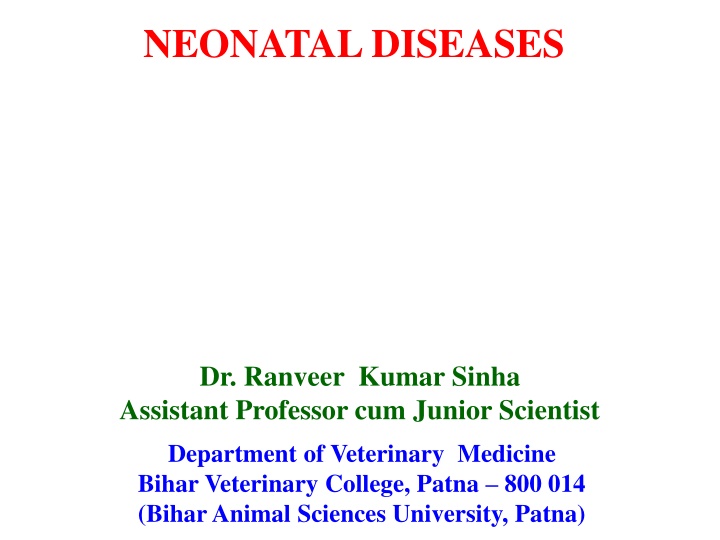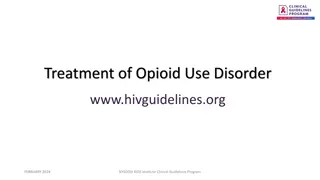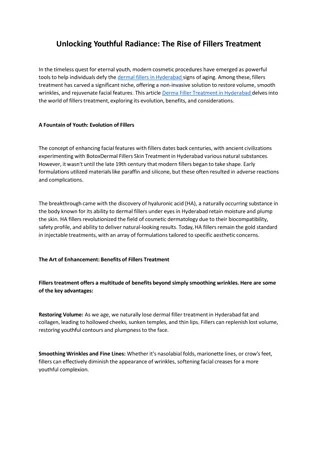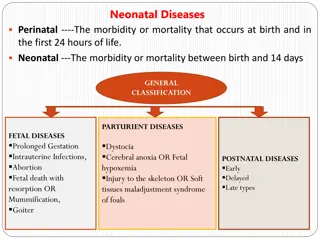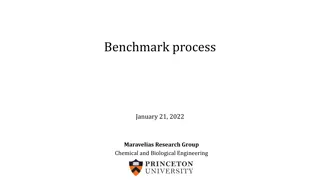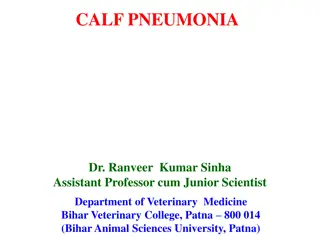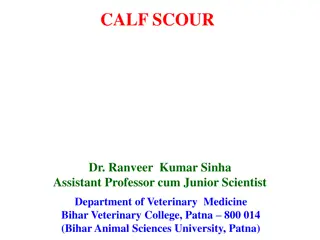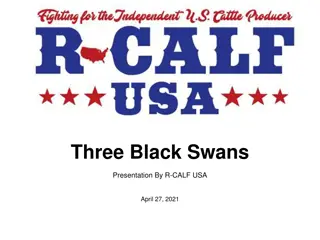Calf Scours & Treatment
Calf scours, a common calf disease, causes diarrhea and dehydration. Recognizing symptoms, types, and when to treat are crucial. Learn more here.
Download Presentation

Please find below an Image/Link to download the presentation.
The content on the website is provided AS IS for your information and personal use only. It may not be sold, licensed, or shared on other websites without obtaining consent from the author.If you encounter any issues during the download, it is possible that the publisher has removed the file from their server.
You are allowed to download the files provided on this website for personal or commercial use, subject to the condition that they are used lawfully. All files are the property of their respective owners.
The content on the website is provided AS IS for your information and personal use only. It may not be sold, licensed, or shared on other websites without obtaining consent from the author.
E N D
Presentation Transcript
NEONATAL DISEASES Dr. Ranveer Kumar Sinha Assistant Professor cum Junior Scientist Department of Veterinary Medicine Bihar Veterinary College, Patna 800 014 (Bihar Animal Sciences University, Patna)
CALF SCOUR Dr. Ranveer Kumar Sinha Assistant Professor cum Junior Scientist Department of Veterinary Medicine Bihar Veterinary College, Patna 800 014 (Bihar Animal Sciences University, Patna)
Introduction It is a important calf diseases Diagnosing, treating and preventing this disease is very important for every cattle industry. Calf scours can be defined as diarrhoea in calves. Calf scours is not a specific disease with a specific cause, but it is actually a clinical sign of a disease complex with many possible causes.
Types of Calf Scours 1.Bacterial scours E.Coli Salmonella Clostridium perfringens Types C & D 2.Viral scours Rotavirus Corona virus Bovine Viral Diarrhoea (BVD) 3.Protozoan Scours Coccidia Cryptosporidia
Symptoms Calves do not drink milk or milk replacer. Calves become severely dehydrated and depressed. They may have fever initially Faeces are watery and often tinged with blood Calves show uneasiness and strain or kick at their abdomen There may be drooling of saliva
When Should Calves be Treated Calves running around the pasture with their tails in the air with yellow or white diarrhoea may need treatment. The main indications for treatment are: General disposition Loss of Appetite Dehydration Body temperature
Recommended Treatments The main treatment is fluid therapy:- 1.R.L.@ 10 20ml/Kg b.wt slow IV according to level of dehydration Secondary treatments are: Antibiotics: Sulphamethoxazole + Trimethoprim oral or parental or other antibiotic Anticoccidial drug Supportive therapay Nursing care.
Prevention and Control General hygienic measure Isolation of infected animal Avoidance of over crowding Provide sufficient colostrum to calf Give dewormer within 10 days after birth Provide feed mixed with coccidiostat Apply Tr. Iodine or Povidone iodine at navel just after birth
CALF PNEUMONIA Calf pneumonia is a Important calf diseases Diagnosing, treating and preventing this diseases is very important for every cattle industry. It is a multifactorial disease and most common in calves between one to five months of age.
TYPES of CALF PNEUMONIA Chronic Pneumonia: It is more gradual in nature with no distinct ill phase & animal still eat but have a slight nasal discharge with an increased respiratory rate and cough. Acute Pneumonia: It is usually more sudden in onset.
CAUSES OF CALF PNEUMONIA Environmental Factors: Low environmental temperature High Humidity Poor Ventilation Infectious Agents: Viral -Bovine Respiratory syncytial Virus (RSV) Bacterial Parasitic Mycoplasma
SYMPTOM OF CALF PNEUMONIA By auscultation of the anterior ventral lung crackles and wheezes & an increase in bronchial sounds especially on inspiration. Dull and depressed High temperature Raised breathing due to lung damage Nasal discharge Coughing Reduced food intake Weight Loss
CONSEQUENCES OF PNEUMONIA Short-term consequences: Reduced dry matter intake, delayed weaning and higher risk of an additional pneumonia event at weaning. Long-term Consequences: Delayed breeding, higher age at first calving and compromised milk production.
Treatment of calf pneumonia Removal of primary etiology: Antibiotics: Enrofloxacine Marboflxacine Cephalosporion . Sulfa &Trimethoprime Antihelmintics: Anti-inflammatory (St & Non St): SupportiveTreatment: Injection of vitamin C and A to increase body immunity Mucolytics & Bronchodilator Antihistaminic Correct anemia if present. Easily digestible and palatable food
PREVENTION OF CALF PNEUMONIA Removal of the cause of diseases Clean environment Proper ventilation. If ammonia can be smelled it is a sign of poor ventilation. Swabbing of the navel with tincture iodine Removal of the newborn from the infected environment Feeding calves inadequately will reduce calf growth and their immune system response which helps fight diseases. Ingestion of colostrums from dam within four to six hours of birth to receive adequate immunity. Special nutritional and housing requirements. Isolation of newborn calf in calf rearing unit within few days after birth.
